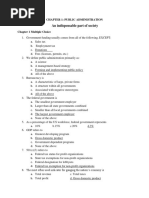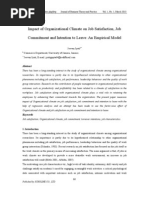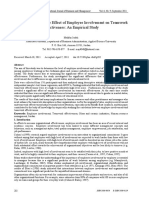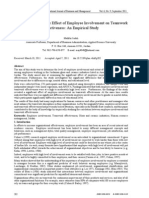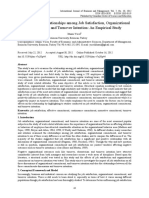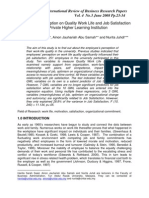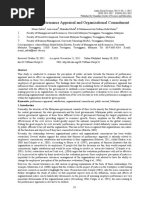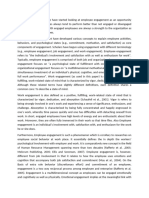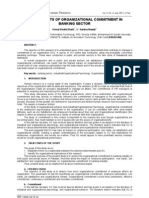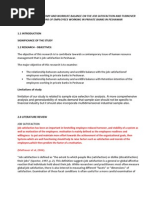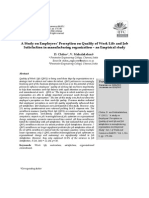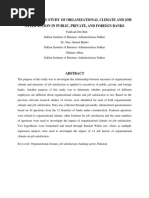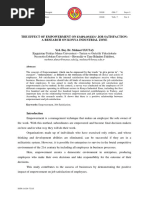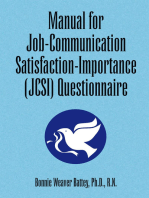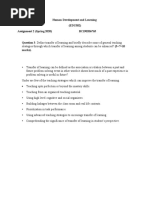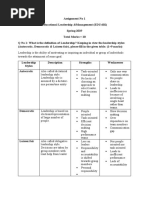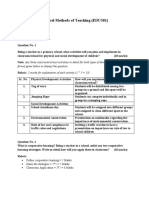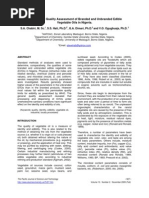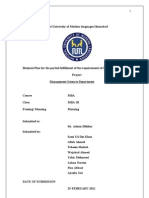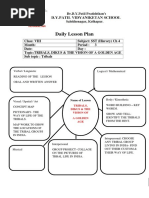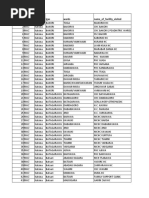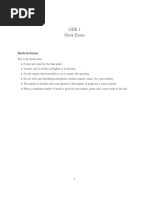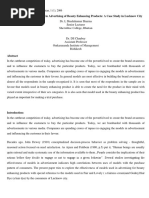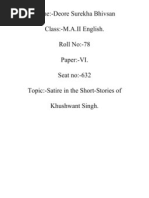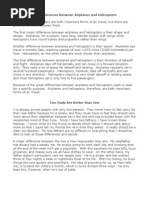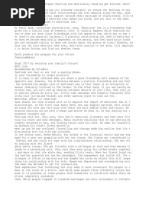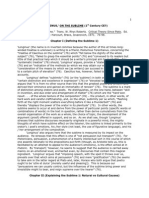Relationship Between Management Style and Organizational Performance: A Case Study From Pakistan
Relationship Between Management Style and Organizational Performance: A Case Study From Pakistan
Uploaded by
Samiuddin KhanCopyright:
Available Formats
Relationship Between Management Style and Organizational Performance: A Case Study From Pakistan
Relationship Between Management Style and Organizational Performance: A Case Study From Pakistan
Uploaded by
Samiuddin KhanOriginal Title
Copyright
Available Formats
Share this document
Did you find this document useful?
Is this content inappropriate?
Copyright:
Available Formats
Relationship Between Management Style and Organizational Performance: A Case Study From Pakistan
Relationship Between Management Style and Organizational Performance: A Case Study From Pakistan
Uploaded by
Samiuddin KhanCopyright:
Available Formats
INTERNATIONAL JOURNAL Of ACADEMIC RESEARCH
Vol. 3. No. 5. September, 2011, II Part
RELATIONSHIP BETWEEN MANAGEMENT STYLE AND ORGANIZATIONAL PERFORMANCE: A CASE STUDY FROM PAKISTAN
Maryam Rafiq , Dr. Saeed-ul-Hassan Chishti
1 2 1 2
MS at Szabist University, Islamabad, Assistant Prof. International Islamic University Islamabad (PAKISTAN) ABSTRACT
This was a descriptive study carried out in different banks of Islamabad. Instruments were used data collection tools. The participants of the study consisted of 100 people. The study revealed an impact of participative management on employee job satisfaction and performance. The research point out there is strong positive relationship among participative management and employee performance. However results show positive moderate relationship between participative management and employee satisfaction. The findings suggest that participative management apply more influence on employee performance than it does on employee job satisfaction. Participative management has considerable strong to moderate outcomes on employee job satisfaction and performance respectively. Key words: Management style, organizational performance, Employee satisfaction 1. BACKGROUND OF THE STUDY The concept of employees participation refers to, in general, the participation of the employees with non-managerial functions in the process of making decisions in the organization (Joseph & Franklin, 1974), considering an interests union between the employer and the employee (Alutto & Acito, 1974), in achieving the long term objectives for the organization and for the persons that work in the organization (Camelia, 2008). The participative management style involves a wide cross-sectional employees in various important decision-making of the organization (Sashkin, 1984). Yohe and Hatfield (2003) states that participative management style involve employee input, allowing the employees to resolve work-related issues. Participative management is utilized to improve work practices, productivity, and organizational performance (Vroom, 1960; Guthri, 2001).Many scholars argue (e.g Wagner, 1994; Finchman & Rhodes, 1994; Scott-Ladd et al. 2006; Bhatti & Qureshi, 2007) that employee participation is likely to increase job satisfaction and performance. Initially, it appears that participative management may lead to high employee job satisfaction and it does seem eminently logical that a happy employee is a better employee which may perform well in the organization. However, thousands of studies have been carried out seeking to establish a positive and unmistakable correlation between participative management, employee job satisfaction and performance with nothing conclusive being proven. The unfortunate consequence of this lack of a clear cause and effect relationship, as Dogan (2009) notes, is that when management discovers there is no guarantee of a one-to-one correlation between participative management, employee job satisfaction and performance interest usually wanes. The investigations studied (presented below) shows that the results about the relationship between participative management and employee job satisfaction and performance are mixed. This relationship is neither certain nor well understood. It has remain unresolved, and inconsistencies in the broader literature on participation make it reasonable for theorists to question whether research has shown evidence of substantial relationships between participative management and satisfaction or performance. The research basically aims at resolving the question that "Does the participative approach to management pay off in terms of employee job satisfaction and performance?" Research results in this area would clarify the relationship. Participative Management Style Participative management has been a growing area of enquiry and debate ever since the seminal work by Lewin and his colleagues. Participative management has been called the "third managerial revolution" (Alutto & Acito, 1974). Scholars have noted that it has become a major social, political and economic issue throughout the world, in a variety of organizational environments (Vroom, 1960). In recent years, the concept of participative management has become a focal point of interest among both scholars and practitioners of administration. Its acceptance has coincided with the increasing contribution of the behavioral science to managerial thought (Powell & Schlacter, 1971). Reportedly there has been a growing movement towards more "participative" methods of decision making. Academicians and practitioners have endorsed participative methods in areas as different as the organization of work and government regulation (Cooke, 1994). Participative management, employee job satisfaction and performance have received considerable attention from psychologists, sociologists and various management scientists. Three thousand studies have been done on these topics by the time Locke prepared his study nearly 20 years ago (Locke & Schweiger, 1979). Organizational change and innovation are not simply a matter of front end planning and back end implementation. Similarly, participation is not just about decision-making process that starts with executive decisions and
290 | www.ijar.lit.az
INTERNATIONAL JOURNAL Of ACADEMIC RESEARCH
Vol. 3. No. 5. September, 2011, II Part
ends up with employees deciding to accept or reject a change. It is more about formulating important decisions outside the planning process and on specific basis by both the management and employees (Perillo, 2008). Participative management can be described as a process in which employees are engaged as motivated co-producers of a better future. It speaks of mutual trust where employees are acknowledged as valuable contributors and co-owners to help develop better decisions. Participative management and autocratic management style are contrary to each other (McCaffry et al., 1995). In evaluation, the participatory approach has been defined as "social research that involves trained evaluation personnel (or research specialist) and practice-based decision makers working in partnership. This approach implies collaboration between facilitators, researchers, or professional evaluators and those who have stakes in the program, project development, or entity. Thus, all groups whose interests are affected by the objective of the evaluation must be involved (Julnes, 2001). In todays intensely competitive global environment, there is a strong demand for workforce participation in organizational decision making to enhance individual performance enabling the achievement of higher productivity of an organization. One aspect of workforce participation is job satisfaction. Job satisfaction in general is defined as how many employees like or dislike their work and the extent to which their expectations concerning work have been fulfilled (Dogan, 2009). Locke (1979) has defined job satisfaction as a pleasurable positive emotional state resulting from the appraisal of ones job experiences. It is considered as positive affect of employees toward their jobs or job situations. Many advocate this definition as it has captured the effective nature of job satisfaction, which is something more like a feeling about ones job rather than their thoughts about it (Finchman & Rhodes, 1994). Job satisfaction is simply as the affective orientation that an employee has towards his or her work (Alutto & Acito, 1974). In other words, it is an affective reaction to a job that results from the comparison of perceived outcomes with those that are desired (Creevy, 1998). Furthermore, it is defined as the degree to which employees enjoy their jobs (John, 1994). Shortly, job satisfaction describes the feelings, attitudes or preferences of individuals regarding work (John, 1994). Researchers perceive job satisfaction as a general attitude, rather than specific or actual (Julnes, 2001). Therefore, job satisfaction varies across different jobs due to different personality attributes and dispositions, nature of job(McCaffry et al,. 1995), positive affectivity, time gap between different job satisfaction surveys, self-esteem and locus of control (Cam elia, 2008). Income, occupation and age had significant effects on job satisfaction at = 0.05 (Guthri, 2001). Huang et al. (2009) study shows that there are approaches of measuring job satisfactionsingle overall feeling towards the job or separate feelings towards different job facets. There is confusion over the exact definition of performance. However it is considered as an important criterion for organizational outcomes and success. The most commonly recognized theories of job performance are given by John P. Campbell and colleagues. According to psychological perspective, Campbell and colleagues described job performance as an individual level variable. Job performance is most commonly referred as whether a person performs their job well (http://en.wikipedia.org). Previous researches propose that participation in decision making affects work practices, rewards and conditions and these are associated with job satisfaction and effective performance. When employees affect the preexistence to work effort, such as problem solving, locus of knowledge, goal setting, satisfaction and performance are improved (Kim, 2002). Further it is discussed that the process is strengthened when employees needs are satisfied and put in towards attaining organizational goals and this as a result would add to satisfaction and employee performance (Scott-Ladd et al., 2006). 2. RESEARCH METHODOLOGY It was descriptive study. The study was conducted in different banks of Islamabad. 2.1. Objectives of the Study Objectives of the study were to: 1. Find relationship between management style and organizational performance 2. Assess link between organizational performance and employee satisfaction 2.2. Sample of the Study The sample was selected by using convenience sampling where the data collection was done from the employees of private banks who were conveniently available to provide it. Sample considered was 100 employees from private banks in Islamabad/Rawalpindi. Private Banks were only selected as participative management styles are more implicated in private banks than in public banks of Pakistan. 2.3. Instrument A single questionnaire (See Appendix) was distributed which was adapted from Scott, Bishop& Chen (2003); Kim (2002). The questions were carefully worded to avoid misinterpretation. The questionnaire layout was formatted in logical manner to ensure a higher response rate. Structured questionnaire were designed. Questionnaire includes only closed-ended questions. Questionnaire was comprised over three sections; first part consisted of questions in order to analyze the participative management style used in organization. The second part of questionnaire consisted of questions in order to identify job satisfaction of the employees. The third part includes assessing the job performance of employees.
B a k u , A z e r b a i j a n | 291
INTERNATIONAL JOURNAL Of ACADEMIC RESEARCH
3. FINDINGS AND DISCUSSION
Vol. 3. No. 5. September, 2011, II Part
Data were collected from five private banks of Islamabad/Rawalpindi region through questionnaire. A pilot survey was done on 50 employees of these banks. Reliability of questionnaire was checked through Cronbachs Alpha that measures how well a set of items measures a single un-dimensional latent construct. The calculated Cronbach's Alpha was 0.894 for 27 items which is presented in Table 1. This value shows that there was consistency among the items and the questionnaire was reliable. Table 1. Reliability Statistics Cronbach's Alpha .894 N of Items 27
Results were analyzed by using the statistical analysis software named Statistical Package for the Social Science (SPSS) version 18.0. The demographic data included name of organization, department, designation, gender, age of respondents, duration of job. Correlation and linear regression tests were applied to analyze the variables where employee job satisfaction (JS) and performance (EP) were treated as dependent variable while participative management (PM) was considered as independent variable. Table 2. Descriptive Statistics Std. Deviation .49603 .50781
PM JS Valid N (listwise)
N Mean 300 3.378 8 300 3.650 6 300
The table 6 indicated that the Pearson correlation coefficient was 0.485; the significance level or (p value) was 0.000. The correlation between participative management and employee satisfaction was 48.5%. It shows positive moderate correlation between the variables. Table 3. Correlations PM 1 JS .485* * .000 1
PM
Pearson Correlation Sig. (2-tailed) Pearson Correlation Sig. (2-tailed)
JS
.485* * .000
**.Correlation is significant at the 0.01 level (2-tailed). The model summary table 3 reports a statistics that measures goodness of fit. This table includes the multiple correlation coefficients, R, its square R2, and an adjusted version of this coefficient. The multiple correlation coefficient, R =.485, indicates that there was a moderate correlation between participative management and employee satisfaction. In terms of variability in observed employee satisfaction accounted for by the fitted model, this amounts to a proportion of R2 =0.235, or 23.5%. It means that there was 23.5% of the variation in employee satisfaction (dependent variable) can be explained by the participative management (independent variable). This shows a positive and moderate relationship between the two variables. The adjusted R2 is an improved estimation of R2 in the population. Use of this adjusted measure leads to a revised estimate that 23.3% of the variability in employee satisfaction in the population can be explained by participative management variable. According to the regression model, the mean deviation is zero (positive and negative deviations cancel each other out). In the table error value was 0.44486 that is not very high. Durbin Watson is 1.621, measuring the auto correlation between independent variables. It is in the acceptable range i.e. 1.5-2.5.
292 | www.ijar.lit.az
INTERNATIONAL JOURNAL Of ACADEMIC RESEARCH
4. CONCLUSION
Vol. 3. No. 5. September, 2011, II Part
In todays competitive world every organization is trying to achieve its competitive edge and it is possible only through its human resource. To satisfy the employees and to motivate them to perform better at work has been the area of concern for many practitioners (Guthrie, 2001). One method used is through participative management style where employees are involved in the decision making of the organization. Researchers and academician are interested to find the impact of participative management in different areas of the organization. The study reveals the impact of participative management on employee job satisfaction and performance. Regression analysis was carried out separately for each dependent variable (employee job satisfaction and performance). The research point out there is strong positive relationship among participative management and employee performance. However results show positive moderate relationship between participative management and employee satisfaction. The findings suggest that participative management apply more influence on employee performance than it does on employee job satisfaction. Participative management has considerable strong to moderate outcomes on employee job satisfaction and performance respectively. REFERENCES 1. Alutto J. & Acito F. (1974). Decisional participation and sources of job satisfaction: A study of manufacturing personnel. The Academy of Management Journal, 17(1), 160-167. Retrieved March 15, 2010, from JSTOR Database, http://www.jstor.org 2. Bhatti K. K., Qureshi T. M. (2007). Impact of employee participation on job satisfaction, employee commitment and employee productivity. International Review of Business Research Papers, 3(2), 54-68. Retrieved Feburary 20, 2010 from www.bizresearchpapers.com 3. Camelia S. (2008). The problems of the participative decision process in business management. Munich Personal RePEc Archive. Retrieved February 25, 2010 from http://mpra.ub.unimuenchen.de/ 4. Dogan H. (2009). A comparative study for employee job satisfaction in aydin municipality and nazilli municipality. Ege Academic Review, 9(2), 423-433. Retrieved April 02, 2010 from http://eab.ege.edu.tr 5. Finchman R., Rhodes P.S. (1994). Motivation and job satisfaction. The individual, work and organization-Behavioral studies for business and management. Oxford: Oxford University Press, Inc., 1994. 6. Guthri J. (2001).High-involvement work practices, turnover, and productivity: Evidence from New Zealand. Academy of Management, 44(1), 180-190. Retrieved March 17,2010, from JSTOR Database, http://www.jstor.org 7. Sashkin M. (1984). Participative management is an ethical imperative. Organizational Dynamics, 12(4), 4-22. Retrieved March 12, 2010,from Wiley Inter Science Database, http://www.intersciencewiley.com 8. Scott-Ladd B., Travaglione A. & Marshall V. (2006). Causal inferences between participation in decision making, task attributes, work effort, rewards, job satisfaction and commitment. Leadership & Organization Development Journal, 27(5), 399-414. Retrieved April 02, 2010, from Emerald database, http://www.emeraldinsight.com 9. Vroom V.H. (1960).Some Personality Determinants of the effects of participation. Prentice-Hall, Englewood Cliffs, N.J. 10. Wagner, John III. (1994). Participations effects on performance and satisfaction: A reconsideration of research evidence. The Academy of Management Review, 19(2), 312-330. Retrieved March 26,2010, from JSTOR Database, http://www.jstor.org
B a k u , A z e r b a i j a n | 293
You might also like
- PA t3Document18 pagesPA t3Phượng TrầnNo ratings yet
- International Journal of Business and Management Studies Vol 4, No 2, 2012 ISSN: 1309-8047 (Online)Document12 pagesInternational Journal of Business and Management Studies Vol 4, No 2, 2012 ISSN: 1309-8047 (Online)Onyeka1234No ratings yet
- Does Organizational Environment Influence Employees' Satisfaction: A Case of Public and Private Organizations OF Pakistan?Document12 pagesDoes Organizational Environment Influence Employees' Satisfaction: A Case of Public and Private Organizations OF Pakistan?Allen AlfredNo ratings yet
- Impact of Organizational Climate On Job Satisfaction, Job Commitment and Intention To Leave: An Empirical ModelDocument17 pagesImpact of Organizational Climate On Job Satisfaction, Job Commitment and Intention To Leave: An Empirical Modelaljimenez6319337No ratings yet
- 1 SM PDFDocument8 pages1 SM PDFKrajaNo ratings yet
- An Examination of The Effect of Employee Involvement On Teamwork Effectiveness: An Empirical StudyDocument9 pagesAn Examination of The Effect of Employee Involvement On Teamwork Effectiveness: An Empirical StudyStriky10No ratings yet
- Herzberg MotivationDocument11 pagesHerzberg MotivationKhurram KhowajaNo ratings yet
- Examining The Relationships Among Job Satisfaction, Organizational Commitment, and Turnover Intention - An Emprirical Study - Ilhamil Youcel - 2012Document15 pagesExamining The Relationships Among Job Satisfaction, Organizational Commitment, and Turnover Intention - An Emprirical Study - Ilhamil Youcel - 2012Duyên PhúNo ratings yet
- Employees' Perception On Quality Work Life and Job Satisfaction in A Private Higher Learning InstitutionDocument12 pagesEmployees' Perception On Quality Work Life and Job Satisfaction in A Private Higher Learning Institutionvidyaiiitm1No ratings yet
- A Study of The Factors AffectingDocument9 pagesA Study of The Factors AffectingEman AlkurdNo ratings yet
- Job Satisfaction and Employee Performanc PDFDocument20 pagesJob Satisfaction and Employee Performanc PDFNatasha DudaniNo ratings yet
- Job Satisfaction and Employee PerformancDocument20 pagesJob Satisfaction and Employee PerformancJane EdullantesNo ratings yet
- Factors Affecting Job Satisfaction in Banking Sector - IndiaDocument4 pagesFactors Affecting Job Satisfaction in Banking Sector - IndiajasonlawkarsengNo ratings yet
- ARM ProjectDocument4 pagesARM ProjectAbdullah AfzalNo ratings yet
- IJMRES 6 Paper Vol 7 No1 2017Document14 pagesIJMRES 6 Paper Vol 7 No1 2017International Journal of Management Research and Emerging SciencesNo ratings yet
- Ed 206 Human Behavior in Organization Activity 3Document16 pagesEd 206 Human Behavior in Organization Activity 3jerasel batillerNo ratings yet
- A Study On Factors Affecting Effort CommDocument16 pagesA Study On Factors Affecting Effort CommDoyoGnaressaNo ratings yet
- Job SatisfactionDocument15 pagesJob SatisfactionNaga Sayana Srinivas KoneruNo ratings yet
- A Study On Employees' Job Satisfaction in Leather Goods Manufacturing CompaniesDocument12 pagesA Study On Employees' Job Satisfaction in Leather Goods Manufacturing Companiesarcherselevators100% (1)
- 1 Merry NirmalaDocument8 pages1 Merry NirmalaMerry NirmalaNo ratings yet
- Impact of Employee Participation On Job Satisfaction in Nepalese Commercial Banks Rishi Ram Chapagai Page 39-51Document13 pagesImpact of Employee Participation On Job Satisfaction in Nepalese Commercial Banks Rishi Ram Chapagai Page 39-51Ivan ClarkNo ratings yet
- OB 2020Document7 pagesOB 2020Wajeeha SiddiquiNo ratings yet
- Leadership ProjectDocument3 pagesLeadership ProjectRaheela MalikNo ratings yet
- Chapter - 2: Review of Related LiteratureDocument15 pagesChapter - 2: Review of Related Literaturemd.jewel ranaNo ratings yet
- Determinants of Organizational Commitment in Banking Sector: I J A RDocument7 pagesDeterminants of Organizational Commitment in Banking Sector: I J A RjionNo ratings yet
- BabalolaSS 2016 TheeffectsofleadershipstyleDocument13 pagesBabalolaSS 2016 Theeffectsofleadershipstyleumanantini06No ratings yet
- Iwb 1Document15 pagesIwb 1Niaz Bin MiskeenNo ratings yet
- Employee Satisfaction: Work-Related and Personal FactorsDocument13 pagesEmployee Satisfaction: Work-Related and Personal FactorsMario KaneNo ratings yet
- Untitled PDFDocument21 pagesUntitled PDFKiran SoniNo ratings yet
- Impact of Employee Engagement On Job Satisfaction and MotivationDocument11 pagesImpact of Employee Engagement On Job Satisfaction and MotivationJeswin BennyNo ratings yet
- Positive EmployeeDocument15 pagesPositive EmployeeMecedilla, Jolly Jules, A.No ratings yet
- CONCEPTUAL FRAMEWORK-Factors Influencing Job Satisfaction Among Public Secondary School Teachers PDFDocument68 pagesCONCEPTUAL FRAMEWORK-Factors Influencing Job Satisfaction Among Public Secondary School Teachers PDFEINSTEIN2DNo ratings yet
- Proposal 123Document8 pagesProposal 123Tariq RahimNo ratings yet
- Impact of Motivational Factors On Employee's Job SatisfactionDocument12 pagesImpact of Motivational Factors On Employee's Job SatisfactionFerri WicaksonoNo ratings yet
- ESI Calculation ModelDocument11 pagesESI Calculation ModelVikas BansalNo ratings yet
- WWWDocument5 pagesWWWBernard OrtineroNo ratings yet
- BR AssgnmentDocument4 pagesBR AssgnmentVittal KumarNo ratings yet
- Science InternationalDocument9 pagesScience InternationalSaadiaSaeedNo ratings yet
- Job Satisfaction and Employee Performance of Greek Banking Staff: An Empirical InvestigationDocument12 pagesJob Satisfaction and Employee Performance of Greek Banking Staff: An Empirical InvestigationAnonymous h8w6FG7No ratings yet
- Assignment On Job Satisfaction: B.B.A. (Hons.) 7 SemesterDocument7 pagesAssignment On Job Satisfaction: B.B.A. (Hons.) 7 SemesterAhmad KhanNo ratings yet
- The Effect of Leadership Style Job Satisfaction An PDFDocument13 pagesThe Effect of Leadership Style Job Satisfaction An PDFJunartoNo ratings yet
- Factors Influencing Job Satisfaction of Academicians in Indian ContextDocument11 pagesFactors Influencing Job Satisfaction of Academicians in Indian ContextsarcolkateeNo ratings yet
- FINAL ESSAY Job Satisfaction PerformanceDocument5 pagesFINAL ESSAY Job Satisfaction PerformanceIsha KembhaviNo ratings yet
- A Study On Employees' Perception On Quality of Work Life and Job Satisfaction in Manufacturing Organization - An Empirical StudyDocument10 pagesA Study On Employees' Perception On Quality of Work Life and Job Satisfaction in Manufacturing Organization - An Empirical StudyInna RamadaniaNo ratings yet
- Factors Affecting Job Performance A Review of Literature PDFDocument14 pagesFactors Affecting Job Performance A Review of Literature PDFYamany Yusda FujiwaraNo ratings yet
- Jahanzaib Research-5Document25 pagesJahanzaib Research-5Nauman AkramNo ratings yet
- Jurnal 18Document8 pagesJurnal 18Vicky ImanNo ratings yet
- 6816 Abdullaha 2019 E R 240805 131623Document21 pages6816 Abdullaha 2019 E R 240805 131623SeptianNo ratings yet
- Servant Leadership and Job Satisfaction: The Moderating Roles of The Decision Making Process and Organizational StructureDocument52 pagesServant Leadership and Job Satisfaction: The Moderating Roles of The Decision Making Process and Organizational StructureNathan EvaNo ratings yet
- Article 4Document23 pagesArticle 4SDK RoboticsNo ratings yet
- Influence of Employee Compensation On Organizational Commitment and Job Satisfaction: A Case Study of Educational Sector of PakistanDocument8 pagesInfluence of Employee Compensation On Organizational Commitment and Job Satisfaction: A Case Study of Educational Sector of PakistannishulalwaniNo ratings yet
- Studies Related To Quality of Work LifeDocument14 pagesStudies Related To Quality of Work LifeNithya PraveenNo ratings yet
- Research PaperDocument15 pagesResearch PaperShreyaNo ratings yet
- Paper1 PDFDocument18 pagesPaper1 PDFSibghaNo ratings yet
- Chapter 1 (Borja Early Joy)Document9 pagesChapter 1 (Borja Early Joy)Early Joy BorjaNo ratings yet
- Exploring The Impact of Flexible Work Arrangements On Employee Engagement and PerformanceDocument14 pagesExploring The Impact of Flexible Work Arrangements On Employee Engagement and PerformancehaibaraNo ratings yet
- 1 PDFDocument9 pages1 PDFMargarita NoredlacNo ratings yet
- 3217-Article Text-6067-1-10-20210419Document6 pages3217-Article Text-6067-1-10-20210419mamdouh mohamedNo ratings yet
- The Effect of Empowerment On Employees' Job Satisfaction: A Research On Konya Industrial ZoneDocument12 pagesThe Effect of Empowerment On Employees' Job Satisfaction: A Research On Konya Industrial ZoneSisay Z AchuNo ratings yet
- How Work Environment Affects The Employee Engagement in A Telecommunication CompanyDocument9 pagesHow Work Environment Affects The Employee Engagement in A Telecommunication CompanyNisreen Al-shareNo ratings yet
- Manual for Job-Communication Satisfaction-Importance (Jcsi) QuestionnaireFrom EverandManual for Job-Communication Satisfaction-Importance (Jcsi) QuestionnaireNo ratings yet
- Human Development and Learning (EDU302) Assignment 2 (Spring 2020) BC190206765Document3 pagesHuman Development and Learning (EDU302) Assignment 2 (Spring 2020) BC190206765Samiuddin KhanNo ratings yet
- EDU 602-Assignment 01Document2 pagesEDU 602-Assignment 01Samiuddin KhanNo ratings yet
- Teaching of English (EDU516) : Assignment # 1 (Fall 2019) Virtual University of PakistanDocument2 pagesTeaching of English (EDU516) : Assignment # 1 (Fall 2019) Virtual University of PakistanSamiuddin KhanNo ratings yet
- General Methods of Teaching (EDU301) : Format Given Below To Attempt The QuestionDocument2 pagesGeneral Methods of Teaching (EDU301) : Format Given Below To Attempt The QuestionSamiuddin KhanNo ratings yet
- Contemporary Issues and Trends in Education (EDU401) : Assignment 2 (Fall 2019)Document4 pagesContemporary Issues and Trends in Education (EDU401) : Assignment 2 (Fall 2019)Samiuddin KhanNo ratings yet
- Theories of ManagementDocument15 pagesTheories of ManagementSamiuddin KhanNo ratings yet
- Finance Research TopicsDocument19 pagesFinance Research TopicsSamiuddin KhanNo ratings yet
- M33MKT - Lecture 3 - Social Media and Online Customer EngagementDocument56 pagesM33MKT - Lecture 3 - Social Media and Online Customer EngagementSamiuddin KhanNo ratings yet
- A Comparison of Team Practices in ECPL and PAFLDocument7 pagesA Comparison of Team Practices in ECPL and PAFLSamiuddin KhanNo ratings yet
- PJST10 2 927Document8 pagesPJST10 2 927Samiuddin KhanNo ratings yet
- Entrepreneurship ProjectDocument19 pagesEntrepreneurship ProjectSamiuddin Khan100% (1)
- Daily Plan 8Document3 pagesDaily Plan 8Yahiya YahiyaNo ratings yet
- SN Zones States Lgas Wards Name - of - Facility - VisitedDocument33 pagesSN Zones States Lgas Wards Name - of - Facility - VisitedSalihu MustaphaNo ratings yet
- Mock Exam 2023Document3 pagesMock Exam 2023JakubNo ratings yet
- MCQDocument9 pagesMCQyatiamenlkrNo ratings yet
- Comparison Between Old Man and The Sea and Farewell To ArmsDocument4 pagesComparison Between Old Man and The Sea and Farewell To Armschintan16593100% (1)
- The Reptilian BrainDocument4 pagesThe Reptilian BrainMahesh MahajanNo ratings yet
- Effectiveness of Model (Latest) PDFDocument9 pagesEffectiveness of Model (Latest) PDFDhani Shanker ChaubeyNo ratings yet
- Public Speaking 13/2/2019Document2 pagesPublic Speaking 13/2/2019Angela Clarence DingNo ratings yet
- Om Assign July 13Document2 pagesOm Assign July 13Janine PanganNo ratings yet
- M.a.english 4 ProjectDocument50 pagesM.a.english 4 ProjectRahul KedareNo ratings yet
- School Form 5 (SF 5) Report On Promotion and Level of Proficiency & AchievementDocument2 pagesSchool Form 5 (SF 5) Report On Promotion and Level of Proficiency & Achievementeliza dela cruzNo ratings yet
- Magnus WILSONDocument312 pagesMagnus WILSONLiberty Fitz-ClaridgeNo ratings yet
- Compare and Contrast Essay ExamplesDocument2 pagesCompare and Contrast Essay ExamplesesmerimNo ratings yet
- Mircea Eliade Paradise and UtopiaDocument3 pagesMircea Eliade Paradise and UtopiaDianora Ungureanu-MaierNo ratings yet
- Are You Having Emotional SexDocument2 pagesAre You Having Emotional SexarpitmatlabNo ratings yet
- Sip 4Document14 pagesSip 4Jsn Pl Cabg-sNo ratings yet
- Deep WaterDocument24 pagesDeep WaterShami ImmanuelNo ratings yet
- FS2 Ep2 MoralesDocument7 pagesFS2 Ep2 MoralesrapmoralesabrantesNo ratings yet
- Annual Plan GR 6Document6 pagesAnnual Plan GR 6white & blackNo ratings yet
- Psychology EE Presentation For Webinar.Document36 pagesPsychology EE Presentation For Webinar.ATID Fabi Rodríguez de la ParraNo ratings yet
- Journal of Social Issues - 2018 - Berdahl - Work As A Masculinity ContestDocument27 pagesJournal of Social Issues - 2018 - Berdahl - Work As A Masculinity ContestouryramNo ratings yet
- Speaking Tips OETDocument6 pagesSpeaking Tips OETintheeyesofshane88% (8)
- Hes Graduation Program 2009.... FinalDocument12 pagesHes Graduation Program 2009.... FinalallannaryanadasNo ratings yet
- Priniciples of Layout DesignDocument14 pagesPriniciples of Layout DesignAlya InsyirahNo ratings yet
- How To Stimulate Your Vagus NerveDocument5 pagesHow To Stimulate Your Vagus Nervetabris_chih_mx100% (8)
- Concern For Order Competency Def-Public ImpactDocument2 pagesConcern For Order Competency Def-Public ImpactKevin Sinaga100% (1)
- Longinus, SublimeDocument13 pagesLonginus, Sublimeninety9No ratings yet
- Extreme Productivity Backpage Notes 3Document2 pagesExtreme Productivity Backpage Notes 3adivishNo ratings yet
- Exceptional Development Juvenile DelinquDocument7 pagesExceptional Development Juvenile DelinquAbdul Rahman MinalangNo ratings yet
